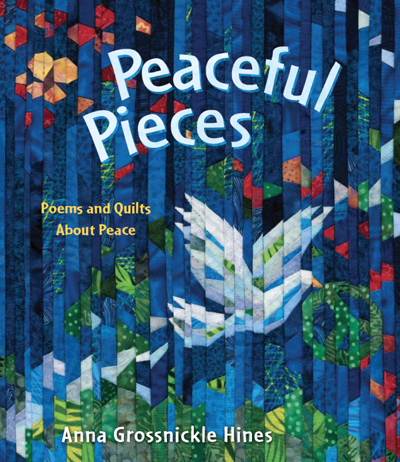
Another Peace Poem
Sliding the fabric under the needle,
feed-dogs down, I draw lines of stitches
defining flowers, butterflies, serene scenes,
quilts for Peaceful Pieces, my next book.
I can’t help but twist my mouth, tilt my head,
hunch my shoulders in the direction I want
the stitches to go, each stitch a prayer.
Behind the hum of the machine the voices
on NPR discuss suicide bombs, starvation,
rape, increased troop levels, torture.
I stitch my quilts, tend my gardens,
send a check to Mercy Corps.
It counts, I tell myself. It all counts.
I sit in meditation on my cushion
sending loving kindness to all beings,
smile at the checker in the market,
sing to the trees, walk on the beach,
listen to the troubles of a friend.
It counts. Quantum physics says
what happens here, happens there.
Everything is sacred. Everything connected.
I stitch and tend and smile and listen and pray
and breathe. It counts.
It all counts.
This poem is not in the book, but was written later, as I was working on the quilts.


This quilt is one I could visualize very early in the process.
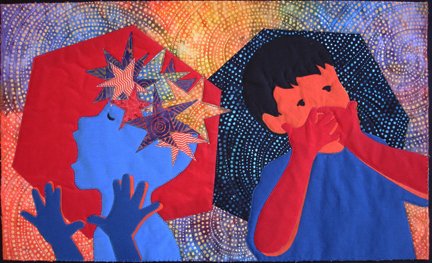
For
this one about calming the busy brain I first experimented with an image inspired by Edvard Munch's "The Scream".

One of two quilts that use silk-screened text in the design, thanks to my friends.
Article on the Mackids blog traces the development of a single quilt.
The PeacemakersOn this quilt I wanted to show several peacemakers. Can you identify any of the eight peacemakers on this quilt? Find out who these peacemakers are and learn more about them. What does it take to be a peacemaker?
|
Here's Flatiron Building from the outside. Holt is on the 10th floor.
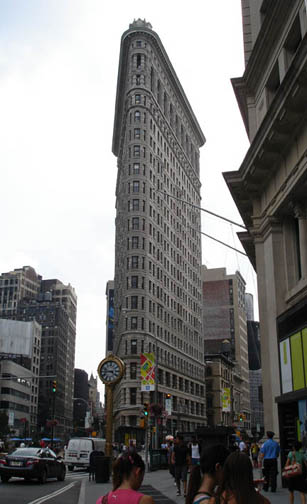
Here's the view from the window at the end, looking uptown, Fifth Avenue straight ahead and Broadway to the left. The trees are in Madison Square Park.
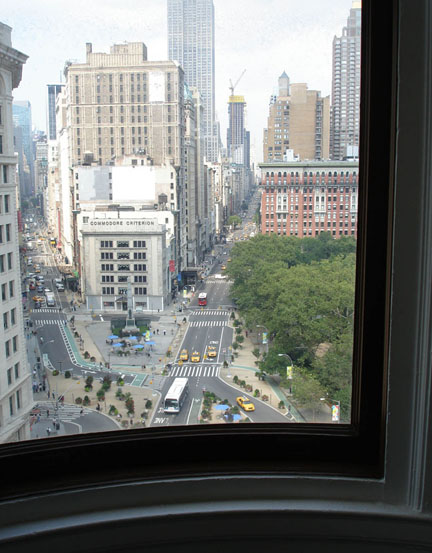
Most of the time I spend writing or quilting I am by myself. But I am not alone. I am a link in a whole chain of writers and quilters. My community of writers and quilters are with me, all of those who will one day read my words and see my pictures are with me, and even those who won’t are with me. All of us together in one world, where everything we do, every action, every thought and every breath, creates the network in which we all live.
Creating
Peaceful Pieces
Writing the Poems
Most of these poems were written over a period of months when, inspired by my writer friends, I set myself the goal of writing a poem a day. Peace has always been important to me, all kinds of peace, from an inner calm to the end of wars all over the earth. My theme for these poems, I decided, would be peace.
Some mornings I woke up with the beginning of a poem in my head, or at least a thought that could lead to a poem. But often I sat down at my computer with my mind a complete blank. Sometimes I opened books that discussed different poetic forms and chose one to try that day. Other days I would just begin typing words and phrases that in some way related to peace, until sooner or later, a poem would begin to grow. Not that all of the poems were good. Many were not and others were not right for this collection. After months of writing, revising, sifting and sorting I finally had enough poems to think about a book.
Art Quilts
I knew I wanted to illustrate the book with quilts, and I knew that would be a new challenge. The poems, though all about peace, are varied in content. Some immediately suggest an image, but others are more abstract. How was I going to translate these concepts into strong graphic images? And how was I going to create a collection of fifteen or more quilts that would feel like they belonged together in one book and not be too jarring as the pages were turned?
When one says “quilt” most people think of a patchwork covering for a bed and for many years, that’s what quilts were. Some were made of whole cloth, but more often they were made of scraps of fabric leftover from sewing clothing, or even the still usable bits of worn out shirts and dresses. Women cut and sewed the pieces together in the evenings and afternoons when they could take time from their work in the house or on the farms. They used traditional patterns, passed down from one to another, or created new ones drawing on the images from nature and objects from their everyday lives. Some of the quilts told stories. Some were made as wedding gifts, or to commemorate a special event. Often, once the tops were all sewn together, or “pieced”, the women gathered at a quilting bee, where they would put a layer of soft wool or cotton between the pieced top and a bottom layer of fabric and stretch it over a large quilting frame. Then they would sit around the frame to quilt, or stitch through all the layers, to make a lovely warm bedcover as they visited with one another.
As more and more things were made with machines, the art of quilt making was largely forgotten. Then in the 1960s it was revived, with thousands of women and some men, too, rekindling an interest. Groups of quilters sprang up all around the world to share knowledge and enthusiasm for quilting. Most used the traditional patterns to make traditional quilts, but others began to make a new kind of quilt, a quilt for the wall instead of the bed. As traditional quilts had done, these new “art quilts” drew from the lives of the creators. Using the traditional techniques of piecing, layering and stitching, the quilters told stories, expressed their feelings, or simply made beautiful works to decorate walls in homes or public buildings. Many of these quilt artists began adding new elements, including stamping, printing, beading, and so on, to add texture, interest, and to say what they wanted to say with their quilts.
Like these art quilters, I wanted to make quilts that would express concepts, tell stories, and give a visual image to my poems. The only difference was, instead of hanging on a wall, though that might happen later, my quilts first purpose was to go into a book. On the Internet, in books, and at quilt shows I looked at hundreds, maybe thousands, of wonderful quilts. I was impressed by the variety, wowed by the designs, moved by the emotion, excited by the techniques. Of course, I could illustrate my poems with quilts. Anything was possible! As generations of quilters before me, I was in good company, part of a community, as I set to work on my quilts.
Getting Started and Finding a Publisher
In one sense, I knew what I was doing, but in another, I didn’t. The whole book, all fifteen or seventeen quilts together, was too big for me to grasp all at once. I needed to get a better idea of some of the parts first, so I started with a few of the poems the quilts that suggested a strong image. Start easy and work toward the harder ones! I made some sample quilts. They didn’t exactly go together, but it was a start.
After quite a few rejections, I found an editor and publisher for the book, Sally Doherty at Holt. And Sally found a designer, April Ward. They were both excited which helped me be excited. A team!
I sent samples and sketches to Sally and April. They liked some but were disappointed in others. I was working on concepts, but not giving enough attention to the visual appeal. This is a book, after all. It will be held in the hands, close up. Each quilt needs to be inviting, draw the viewer in. For several months we went back and forth. I was grateful for their helpful comments, and had a much better vision of many of the quilts, but a few still eluded me, and I was still concerned about how they were all going to fit together. I had decided that it would help if the colors and patterns of the fabric could carry over from one page to the next, a bit of something familiar with each page turn, along with the new image. I needed a new collection of fabrics.
Shopping!
Each January my mother and her quilting group goes to the Road2California Quilt Show. This year, as I had done several times before, I joined them, with the specific goal of finding fabrics for Peaceful Pieces. Three days to be inspired by quilts, talk quilts and search dozens of vender booths for the patterns and colors I needed. I’d walk the aisles, looking at the fabrics in the booths, then go back to my room, lay out my designs and think. Then back to the aisles. I kept being drawn to the batiks; such a variety of colors and patterns, darks and lights. I bought a few and spread them out on the bed in my room. That was it. The batik fabrics, used throughout the book, paying attention to the quilts that would go before and after each quilt as I made them, would help me pull the book together. I started buying in earnest, half yard pieces, fat quarters and fat eighths. Several booths specialized in batiks and I went back to them again and again, making sure I had greens, yellows, reds, blues, darks, lights, mediums. A lot of the ones that appealed to me had dots. That could work in my favor, too.
I scanned the new fabrics and put them into the designs, and began making the quilts. Continuing to get Sally and April’s input I finished one after another, until I was down to four. For two of them, I needed still more fabric; blues and yellows which I found in a shop about two hours away. On the other two, I wanted to print words on the fabric. I experimented with stenciling and stamping, but wasn’t happy with the results. Once again, I needed my quilt community.
Quilters to the Rescue!
I belong to the Pacific Piecemakers Quilt Guild which has about 120 members, a surprising number for such a small community. In addition to the monthly guild meetings, some get together in small groups where more experienced quilters help beginners, and we bounce ideas off one another, or show off our latest project. A few times a year the guild has work days to make “Comfort quilts” which we give to people who are sick or have lost a loved one, or “Quilts of Valor” for wounded soldiers in the VA hospital.
One of my friends in the guild often stamps words onto her quilts, so I asked her advice. She suggested I try silk screening. “Talk to Judy,” she said. “She has a Thermofax machine that can make a screen for you.” Judy was more than happy to make the screens, but didn’t have any silk left. Another friend offered to share her silk, but then I needed a frame. I sent an email to the group and two members immediately offered to loan frames. With their advice and some information I found on the larger Internet community, I successfully printed the words on my last two quilts. The times and methods have changed, the looks of the quilts has changed, but the sense of community, the storytelling, sharing the joy of creating something beautiful or useful has not.
The Finish Line
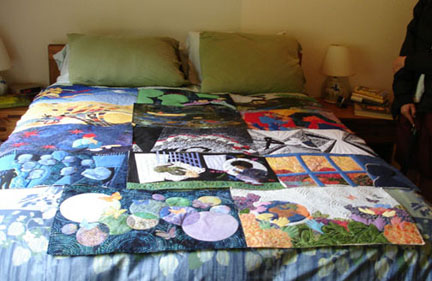
I spread the fifteen quilts out on my bed for one last look before taking them off to New York so the editor and designer, the production and marketing people can continue the process of making them into a book. Just as I’d hoped, the colors flow from one quilt to another. Though each is unique, like the poems and like people, they do all belong together. I wrote the poems, and I made the quilts, but not without a lot of support and encouragement from my writing friends, my family, the quilting community, and the publishing team.
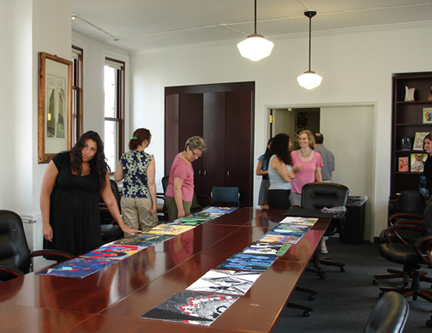
In August of 2009 I made the trip to New York City to deliver the quilts. It was such fun to take them in person and see the reaction of all the people who would now put my work into a book and take it to market. Henry Holt is in the famous Flatiron Building and we met spread the quilts out on a table in the long triangular room.

I still had the title page and cover to do...which went through many design permutations before we all agreed on the final version. I finished I sent it in early January, more than a year before it will actually be a book.
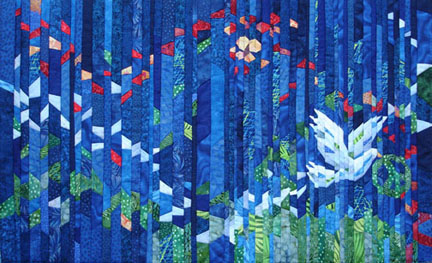
Reviews:
![]() In Pieces: A Year in Poems & Quilts(2001), Hines took her books in a new direction, creating quilts to illustrate poems written around a central theme. Her newest jewel-bright offering showcases 28 short poems about peace, a broad concept interpreted here in varied ways. The narrative poems wind their way to the central point, while the haiku and acrostics are brief and pithy. The most effective pieces are the most specific and personal, even when their connection to peace seems, at first, oblique. Several poems interpret the theme in ways that speak directly to a child's experience, while others reflect a broader view.
In Pieces: A Year in Poems & Quilts(2001), Hines took her books in a new direction, creating quilts to illustrate poems written around a central theme. Her newest jewel-bright offering showcases 28 short poems about peace, a broad concept interpreted here in varied ways. The narrative poems wind their way to the central point, while the haiku and acrostics are brief and pithy. The most effective pieces are the most specific and personal, even when their connection to peace seems, at first, oblique. Several poems interpret the theme in ways that speak directly to a child's experience, while others reflect a broader view.
The most striking aspect of the book is its quilted, pieced-cloth artwork, and the borderless pages allow maximum impact for Hines' bold, expressive visual statements. Two of the spreads are created mainly in black and white, while, in others, colors, patterns, and stitched lines create a rich variety of effects, from scenes creating a surprising illusion of depth to bold images that seem to rise from their backgrounds. In the closing pages, Hines comments on the process of quilting and identifies the eight peacemakers photographically represented in one of the illustrations. A beautiful poetry book on an ever-relevant theme.— ALA Booklist January 2011, Carolyn Phelan (starred review)
![]() Hines pairs poems with images of her handmade quilts to reflect on the theme of peace. Several works focus on individual realtionships: when two sisters fight, their mother makes them face each other at close range, which diffuses their anger into laughter (It's hard to keep on fighting/ when you're touching nose to nose"). Poems like "Soldier Daddy" are socially resonant: "Daddy?/ Are you not listening again?/ Are you still sad from the war?" Often Hines needs just a few words to convey oceans of meaning: "Peace is/ when all of them/ are us." The beauty and painstaking detail evident in each quilt brings the book's vision a stitch closer. Ages 4-8 Publisher's Weekly November 2010 (starred review)
Hines pairs poems with images of her handmade quilts to reflect on the theme of peace. Several works focus on individual realtionships: when two sisters fight, their mother makes them face each other at close range, which diffuses their anger into laughter (It's hard to keep on fighting/ when you're touching nose to nose"). Poems like "Soldier Daddy" are socially resonant: "Daddy?/ Are you not listening again?/ Are you still sad from the war?" Often Hines needs just a few words to convey oceans of meaning: "Peace is/ when all of them/ are us." The beauty and painstaking detail evident in each quilt brings the book's vision a stitch closer. Ages 4-8 Publisher's Weekly November 2010 (starred review)
From: BookPage.com - Sweet Words for Little Readers:
More creative illustrations are waiting in Peaceful Pieces: Poems and Quilts about Peace by Anna Grossnickle Hines, a follow-up to her lovely A Year in Poems and Quilts. Hines' illustrations are photographs of her own amazing, handmade quilts. And phenomenal they are, with wonderful backgrounds and vibrant colors, patterns and textures, and people, too, such as a boy in a kayak or a curly-haired girl holding a butterfly.
Hines' poems are just as wonderful and varied as her quilts, discussing peace in its many forms, whether between a hamster and a snake, siblings, schoolmates, armies or countries. There's plenty of food for thought here, including a spread dedicated to eight peacemakers, ranging from Gandhi and Martin Luther King Jr. to child peacemakers Samantha Smith and Mattie Stepanek.
Hines ends her book with a few pages explaining who these peacemakers are, and also discusses how she created her quilts. She relates the long history of quilt-making, storytelling and artistic and community collaboration. This is indeed a treasure trove of beauty and inspiration.
Reviews: Continued
Using exquisitely detailed handmade quilts as a backdrop, Hines's poems explore the overarching themes of peace, understanding, tolerance, and friendship. The diverse selections illustrate the ways in which peace relates to everyday life and are presented in a variety of formats and contexts. For example, one poem is told from the perspective of a child whose father came back from war a changed man. Another uses the game of dominoes as a metaphor for the idea that human beings influence one another in far-reaching ways. The quilts that accompany the selections serve to expand upon their themes and create an interesting contrast to the text. Children will be fascinated by the painstakingly intricate stitching, bold colors, and poignant imagery. In an author's note, Hines describes her writing and quilt-making processes. Mini-biographies of eight influential peacemakers, including Mother Teresa and Gandhi, are included. This book would be perfect for reading aloud and also appropriate for independent reading by poetry-loving children. Because of its unique presentation and breadth of subjects, Peaceful Pieces would be a good companion to Vladimir Radunsky's What Does Peace Feel Like? (S & S, 2004). While some of the poems are more moving than others, the collection as a whole underscores the importance of people finding common ground despite their differences.–Gr 1-5
Rita Meade, School Library Journal, February, 2011
Hines' art is always beautiful; she illustrates her work with astonishing quilts, reproduced full-size, in a variety of designs: In this work she uses black-and-white reverse patterns, mosaic-type images, photographs made into quilt patterns and lots and lots of gorgeous color. She uses this abundance of styles in her poems, too, offering acrostic, haiku, rhymed and free verse as well as concrete poetry ("Peace. Pass it on," repeats over and over around a quilted globe, held by quilted hands of many colors, including orange and purple). In "What If?" she muses, "What if guns / fired marshmallow bullets, / and bombs burst / into feather clouds / sending us into fits / of giggles? What if / we all died / laughing?" It is very difficult to write about peace for children—or anyone else—without sinking into bathos or pure sappiness, and this collection doesn't always rise above, but these missteps are small. Brief paragraphs about various peacemakers at the back, including two children (Samantha Smith, 1972–1985, and Mattie Stepanek, 1990–2004), tether the poems to reality; her description of making the quilts and the support of her quilters' group is wonderful in and by itself for both children and adults to read. A poem about two sisters made to stand nose-to-nose until they stop fighting and dissolve into giggles is a truly fine idea—wonder if it would work with world leaders? (Picture book/poetry. 5-10) Kirkus Reviews, February 15, 2011
Pieces: A Year in Poems and Quilts
Winter Lights: A Season in Poems and Quilts
Quilting Glossary and a Bit of History
Quilts, Dolls, and Books
Quilts in the Classroom
Quilter's Page
Top of Page
Guide
Home
